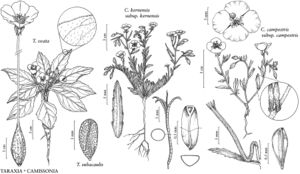Taraxia subacaulis
Mem. New York Bot. Gard. 1: 281. 1900.
Herbs usually glabrate, rarely sparsely strigillose, especially on leaf-blade veins and margins; taproot thick, deep, sometimes branched in age, producing new rosettes. Leaves 2–22 × 0.7–4.2 cm; petiole narrowly winged, 1–12 cm; blade lanceolate to narrowly elliptic, base attenuate, margins usually subentire to sinuate, sometimes deeply and irregularly pinnatifid, apex acuminate. Flowers opening near sunrise; floral-tube 1.5–3 mm, with short, matted hairs inside near base; sepals 4–15 mm, mostly glabrous, sometimes very minutely strigillose; petals yellow, 5–16 mm, often apiculate; episepalous staminal filaments 1.8–6.5 mm, epipetalous ones 0.5–2.5 mm, anthers 0.9–2 mm; sterile prolongation of ovary 15–80 mm, style 4–8.5 (–11) mm, glabrous or sparsely pubescent near base, stigma usually surrounded by longer anthers at anthesis, rarely exserted beyond anthers. Capsules 4-angled, oblong-ellipsoid, 11–28 × 5–8 mm, walls thick, scarcely distended by seeds, becoming blackened and persistent on plants for 1+ years after shedding seeds; rarely with pedicel to 10 mm. Seeds uniformly tan to light-brown, ellipsoid-oblanceoloid, 1.3–1.9 × 0.6–1 mm, coarsely pitted. 2n = 14.
Phenology: Flowering late Mar–Jul.
Habitat: Meadows, seasonally moist open places, from foothills to mountains.
Elevation: 400–2900 m.
Distribution
Calif., Colo., Idaho, Mont., Nev., Oreg., Utah, Wash., Wyo.
Discussion
Taraxia subacaulis occurs well inland from Pacific coastal areas. Its only occurrence in Colorado is in Moffat and Routt counties. P. H. Raven (1969) determined Taraxia subacaulis to be self-compatible and, usually, facultatively autogamous. The species is distinctive, but is sister to T. tanacetifolia in molecular analyses (R. A. Levin et al. 2004; W. L. Wagner et al. 2007).
Selected References
None.
Lower Taxa
"thin" is not a number.
